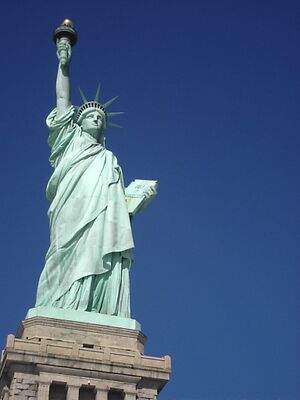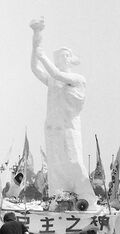Statue of Liberty

It was the Goddess of Liberty who inspired the idea of the Statue of Liberty as a gift of the people of France to the people of the United States.
Sculptor Frédéric Auguste Bartholdi designed and constructed the statue of Liberty in response to the flame of Liberty focused in southern France at the etheric retreat of Paul the Venetian, le Château de Liberté. The figure, entitled Liberty Enlightening the World, was presented by the people of France to the U.S. in 1885 in commemoration of their alliance during the American Revolution. It was dedicated on Bedloe’s Island October 28, 1886.
A symbol of the friendship of the two nations and more, it was the spanning of the arc of liberty from the Château de Liberté back to the Temple of the Sun with the intent that the descendants of Atlantis reembodied at both her East and West gates (at France and the United States) would hold high her torch until Liberty’s culture should once again appear in a golden age founded upon the balanced and expanded threefold flame in the hearts of the freedom-loving people of these sister nations.
Symbolism of the statue
The Goddess of Liberty wears a crown of seven rays, focusing the power of the Elohim and their implementation of the seven rays in form, in Matter (Mater), the mother aspect of Divinity. Her crown is also a focus of the seven rays anchored in the forehead of every son and daughter of God.
The Goddess of Liberty represents the “Lady with the lamp” whom Henry Wadsworth Longfellow prophesied would “stand in the great history of the land, a noble type of good, heroic womanhood.”[1]
The Goddess of Liberty represents the archetypal pattern of the World Mother who carries the Book of Divine Law, the Book of Illumination containing the knowledge that will show mankind the way out of the night of human error. The 23' 7" tablet in the hand of the Statue of Liberty represents this Book of the Law—a symbol inspired upon the sculptor, Frédéric-Auguste Bartholdi, by friends in the French organization of Freemasons. The inscription of the Declaration of Independence was added as an afterthought to personalize the gift.
At the base of the Statue of Liberty are broken chains, symbolizing a being free from the bondage of human creation, stepping forth to enlighten the world. Her torch is the flame of cosmic illumination.
Beloved Kuan Yin has spoken of the Statue of Liberty:
Blessed hearts, have you ever thought, symbolically, that the climb to the very crown of the Statue of Liberty is the following of the spiraling steps of the Kundalini or even of the DNA chain of the I AM Race that is guarded by the Lady with the Lamp?
Have you ever thought that climbing that stairway, round and round, is a passageway to the secret chamber of her heart, to the interior castle, and to the path of the secret rays?
Blessed ones, even the windows around the crown denote the opening of the pathway—twelve open doors of initiation, symbolized by the seven rays in her crown and the five that are in her heart.[2]

The “Goddess of Democracy” statue
The Statue of Liberty in New York Harbor was the inspiration for the 30-foot statue of the “Goddess of Democracy” created by the Chinese students who demonstrated for freedom in China during April and May of 1989. Although the statue was originally called the “Goddess of Liberty” in Chinese, it became popularly known in China and subsequently in the West as the “Goddess of Democracy” because it represented the Chinese people’s aspiration for political reform and democracy.
See also
Sources
Mark L. Prophet and Elizabeth Clare Prophet, The Masters and Their Retreats, s.v. “Goddess of Liberty.”
Mark L. Prophet and Elizabeth Clare Prophet, The Masters and Their Retreats, s.v. “Paul the Venetian.”
Pearls of Wisdom, vol. 24, no. 12, March 22, 1981.
Pearls of Wisdom, vol. 29, no. 65, November 12, 1986.
Pearls of Wisdom, vol. 32, no. 41, October 8, 1989.
